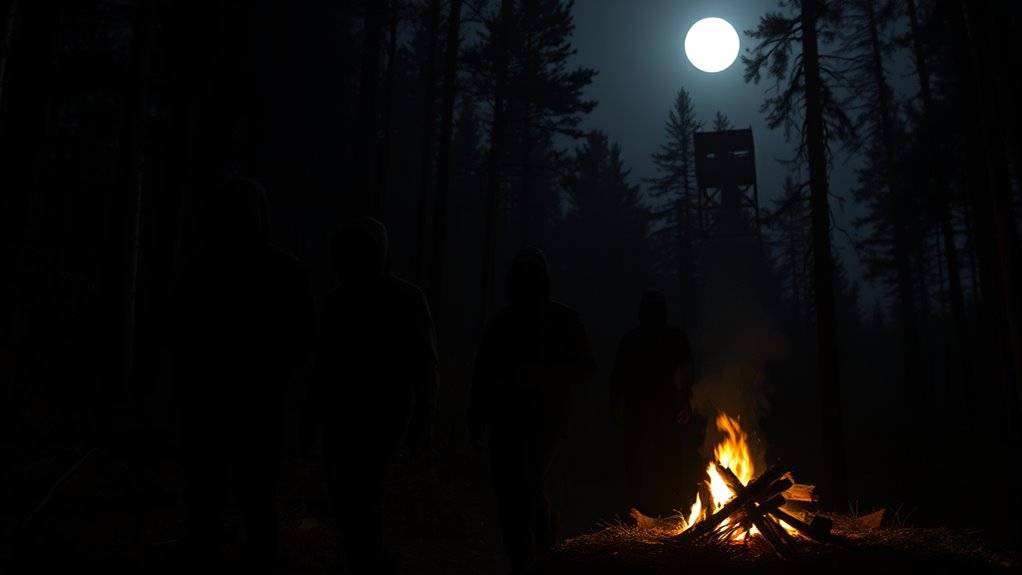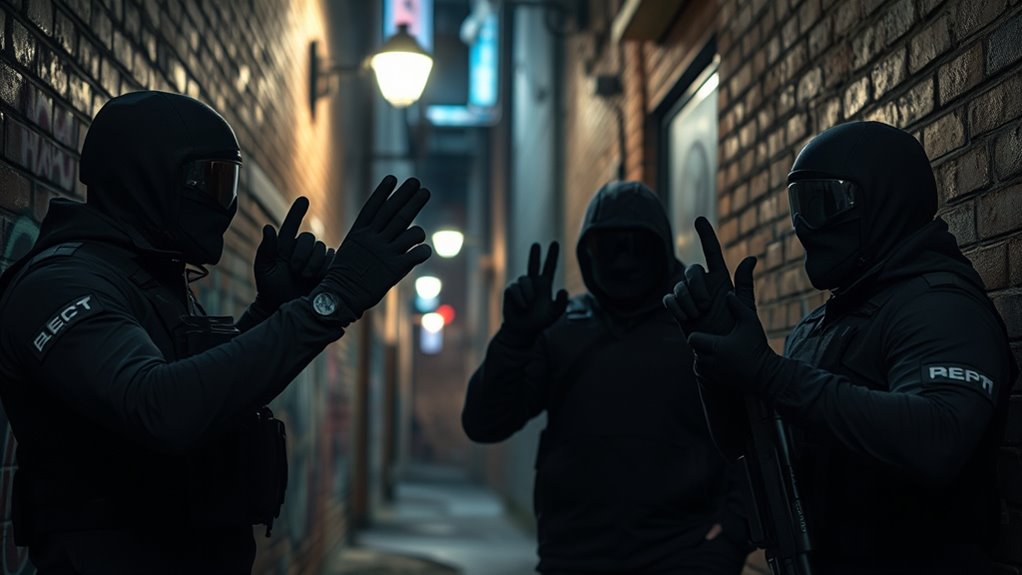To stay covert with your stealth crew, rely on silent signals like simple hand gestures and coded signs. These non-electronic methods let you communicate discreetly, keeping your operation secure and undetected. Practice these signals regularly to guarantee quick understanding and execution even in challenging conditions. Using clear, deliberate gestures maintains team coordination without sound or electronic trace. Keep exploring for more effective tips on mastering silent communication and enhancing your team’s stealth capabilities.
Key Takeaways
- Silent signals enable discreet, non-electronic communication crucial for maintaining stealth and avoiding detection.
- Designing simple, universal gestures ensures quick recognition and reduces confusion during covert operations.
- Incorporating coded gestures enhances security, allowing only team members to understand specific commands.
- Regular training and practice improve execution and reliability of silent signals in challenging environments.
- Effective use of silent signals ensures team coordination, quick response, and sustained operational security.

When operating in stealth mode, relying on electronic communication can compromise your team’s cover. Radios, phones, or any digital devices are easy to intercept or trace, risking exposure and jeopardizing the mission. That’s why mastering silent signals becomes vital. Hand signals and coded gestures allow your team to communicate quickly and discreetly without making a sound or revealing your intentions to outsiders. These non-electronic methods help maintain the element of surprise and guarantee that everyone stays aligned, even in the most covert situations.
You need to develop a clear set of hand signals that everyone understands and can execute instinctively. For example, a raised hand with fingers extended might mean “hold position,” while a fist could signify “advance” or “stop.” These signals should be simple, universal, and easily distinguishable in low-light or high-stress scenarios. When practicing, focus on making gestures smooth and deliberate but also swift enough to convey messages without drawing attention. Remember, the goal is to be silent and efficient. Overcomplicating gestures can lead to confusion or delayed responses, so keep your signals straightforward.
Coded gestures add an extra layer of security to your silent communication. They can be as simple as a specific hand sign that means “move now,” or a series of gestures that form a code understood only within your team. These coded gestures are especially useful when multiple commands need to be relayed quickly. You might use a particular hand movement to indicate a change in plans or to signal withdrawal. The key is consistency—everyone must memorize and interpret the gestures the same way, to avoid miscommunication during critical moments.
Training your team on these signals is vital. Regular practice ensures that each member can recognize and execute the gestures instinctively, even under stress. During drills, simulate real-world conditions with distractions, low visibility, and noise, so everyone becomes comfortable with silent communication. It’s also wise to have backup signals in case your primary gestures are misunderstood or obscured. Always verify that your team is on the same page, and encourage feedback to refine your system.
In high-stakes operations, effective non-electronic communication can be the difference between success and failure. Hand signals and coded gestures provide a reliable, secure way to coordinate your team without risking exposure. By establishing clear, practiced signals, you guarantee that your team remains silent, coordinated, and ready to adapt at a moment’s notice. This silent language becomes an invisible thread that keeps your team unified, no matter how challenging the environment. Incorporating appropriate training on these gestures ensures your team can rely on their silent language efficiently.
Frequently Asked Questions
How Do I Teach Team Members New Non-Electronic Signals?
To teach your team new non-electronic signals effectively, start with visual cue training, demonstrating each signal clearly. Guarantee signal consistency so everyone understands and remembers the cues. Practice frequently in different scenarios to reinforce learning, and encourage feedback to refine the signals. By maintaining uniformity and using visual cue training, your team will quickly adapt to new signals, boosting communication efficiency during stealth operations.
What Are Common Mistakes in Silent Communication?
When you consider common mistakes in silent communication, focus on gesture consistency and cultural sensitivity. You might assume everyone interprets signals the same way, but inconsistency in gestures can cause confusion. Additionally, failing to account for cultural differences may lead to misunderstandings or offense. To avoid these mistakes, guarantee your signals are clear, consistent, and respectful of all team members’ backgrounds, fostering effective and respectful non-electronic communication.
How Can Signals Be Adapted for Different Environments?
Remember, “adapt or perish.” To tackle environmental challenges, you must utilize adaptive signaling tailored to each setting. Observe the environment carefully, adjusting your signals for visibility, noise levels, and terrain. For outdoor spaces, use visual cues like hand signals or flashlights, while in noisy places, rely on tactile or subtle gestures. Flexibility in your communication ensures your crew stays synchronized, no matter the environment you face.
What Safety Precautions Should Be Taken With Non-Verbal Cues?
When using non-verbal cues, you should prioritize hand signal clarity to avoid misunderstandings. Be aware of cultural differences that could affect how signals are interpreted, ensuring everyone understands the intended message. Always practice signals beforehand, maintain consistent gestures, and confirm understanding with your team. By doing so, you minimize safety risks and enhance communication efficiency, keeping your stealth crew safe and coordinated in any environment.
How Do You Ensure Clear Understanding Among Diverse Team Members?
Think of your team like a symphony, each member’s unique instrument representing different backgrounds. To guarantee clear understanding, you must master signal consistency, like a conductor guiding the orchestra. Be mindful of cultural differences that influence interpretation, just as different instruments produce varied sounds. Regularly check in, clarify signals, and adapt communication styles, so everyone stays in harmony, avoiding discord and ensuring your message resonates across diverse team members.
Conclusion
By mastering silent signals, you build trust and cohesion with your stealth crew without risking electronic traces. Some might worry this limits your communication, but in truth, it strengthens your bond and sharpens your senses. Don’t let fear of complexity hold you back—these subtle cues become second nature, empowering you to stay connected even in the most covert situations. Trust in these signals, and you’ll keep your team safe, agile, and always one step ahead.










